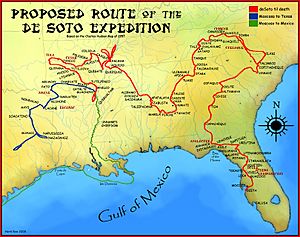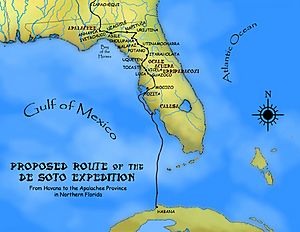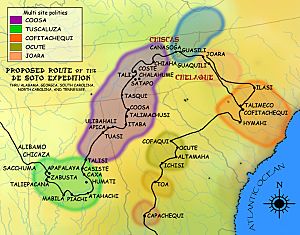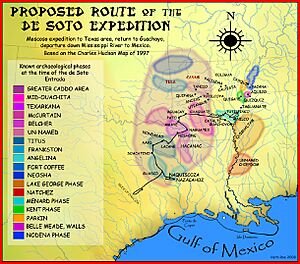List of sites and peoples visited by the Hernando de Soto Expedition facts for kids
This article lists the places and Native American groups visited by the Hernando de Soto Expedition between 1539 and 1543. In May 1539, de Soto left Havana, Cuba, with nine ships, over 620 men, and 220 horses. They landed in Charlotte Harbor, Florida. This was the start of a three-year journey across the southeastern part of North America. Many men, including de Soto himself, did not survive this long trip.
During their journey, the expedition met many different Native American groups. Most of these groups were part of the widespread Mississippian culture. Only a few of these ancient cultures continued into the 1600s. Others are only known from the written records of de Soto's expedition.
Contents
- Exploring Florida: First Steps of the Expedition
- Journey Through Georgia: Meeting Muskogean Speakers
- South Carolina: The Powerful Cofitachequi
- North Carolina: Exploring New Lands
- Tennessee: Along the Rivers
- Alabama: Meeting Chief Tuscaloosa
- Mississippi: Crossing the Great River
- Arkansas: Discovering Ancient Sites
- Texas: The Westernmost Point
- See also
Exploring Florida: First Steps of the Expedition
The de Soto expedition began its long journey in Florida. They explored many areas and met several Native American groups. These groups had their own villages and ways of life.
Here are some of the places and groups they visited in Florida:
- Uzita
- Mocoso
- Urriparacoxi
- Timucua
- Ocale
- Acuera
- Potano
- Alachua culture
- Northern Utina
- Yustaga
- Uzachile
- Anhaica
- Apalachee
- Narváez expedition's "Bay of Horses"
Journey Through Georgia: Meeting Muskogean Speakers
The expedition traveled through Georgia twice. The Native American groups they met here spoke Muskogean languages.
First Trip Through Georgia
The first journey went northeast towards Cofitachequi in South Carolina.
After leaving Ocute, the expedition crossed a wild area known as the "Wilderness of Ocute." This area is now the Savannah River basin. They then arrived in what is now South Carolina. Some items from this part of their journey have been found in Telfair County, Georgia.
Second Trip Through Georgia
The second journey went southwest from Tennessee. During this part, they visited the Coosa chiefdom. All the land they crossed was controlled by Coosa. This was a very powerful chiefdom with land in Georgia, Alabama, and Tennessee.
- Coosa chiefdom
- Little Egypt, likely the main village of Coosa
- Sixtoe Mound
- Bell Field Mound Site
- Talimachusi
- Etowah Indian Mounds (Itaba)
South Carolina: The Powerful Cofitachequi
In South Carolina, the main goal of the expedition was to reach the powerful chiefdom of Cofitachequi. The people of this chiefdom were likely the ancestors of today's Cherokee and Catawba tribes.
- Hymahi
- Cofitachequi, probably located at the Mulberry Plantation today
- Talimeco
North Carolina: Exploring New Lands
The de Soto expedition also traveled into what is now North Carolina. Here they encountered more Native American groups.
Tennessee: Along the Rivers

As the expedition moved into Tennessee, they continued to meet various Native American communities, often located near rivers.
Alabama: Meeting Chief Tuscaloosa
Parts of the Coosa chiefdom also reached into Alabama. Another very important chiefdom the expedition met was led by Chief Tuscaloosa. The people they found in Alabama were likely the ancestors of today's Creek, Alabama, and Choctaw tribes.
- Abihka
- Chief Tuskaloosa
- Mabila
- Tali
Mississippi: Crossing the Great River
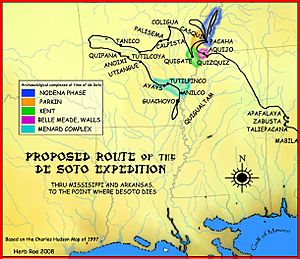
The expedition continued its journey through Mississippi, encountering more Native American groups. This region was home to several distinct communities.
- Chicaza
- Quizquiz
- Walls phase
- Quigate
- Quigualtam
- Natchez people
Arkansas: Discovering Ancient Sites
In Arkansas, the de Soto expedition came across more Native American settlements. Some of these places are now important archaeological sites.
- Aquixo
- Casqui, many archaeologists believe this is the same as the Parkin Archeological State Park
- Pacaha, many archaeologists believe this is the Nodena site
- Chaguate
- Coligua
- Tunica people
- Tula people
- Anilco, possibly the Menard complex in the southeastern part of the state
- Guachoya
- Quapaw
- Caddoans
Texas: The Westernmost Point
All the groups the expedition met in Texas were ancestors of the modern Caddo people. This includes the Hasinai and Kadohadacho confederacies. The Caddo guides intentionally led the expedition in circles. Because of this, the Spanish only met a few major Caddo centers, even though many more were nearby.
Eventually, the expedition had to turn back after reaching the "River of Daycao." This river is thought to be the Brazos, Trinity, or even the Colorado. Beyond Daycao, the expedition's writers claimed that people did not grow corn. Instead, they lived by hunting and gathering food from the land.
This part of the expedition happened after both de Soto and his main translator, Juan Ortiz, had passed away. Because of this, the records from this time are not as detailed as earlier parts of the journey.
- Caddo
- Nadaco (Nondacao)
- Hasinai
- Soacatino
- Adai (Native American culture)
See also
 In Spanish: Expedición de Hernando de Soto en La Florida para niños
In Spanish: Expedición de Hernando de Soto en La Florida para niños
- Alabama language
- Caddoan languages
- Cherokee language
- Chickasaw language
- Choctaw language
- Creek language
- Etowah Indian Mounds
- Hitchiti
- Lake Jackson Mounds Archaeological State Park
- Lake Village, Arkansas
- Mississippian culture
- Moundville Archaeological Site
- Ocmulgee National Monument
- Pisgah phase
- Southeastern Ceremonial Complex
- Timucua language
- Yamasee
- Yazoo tribe


